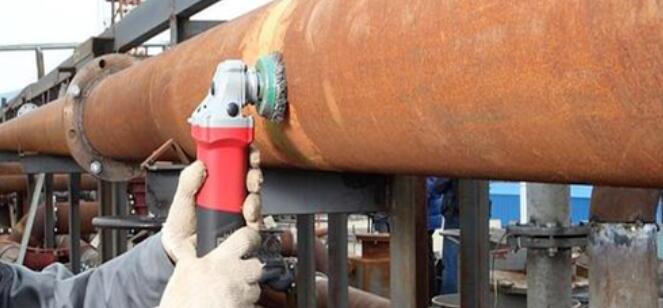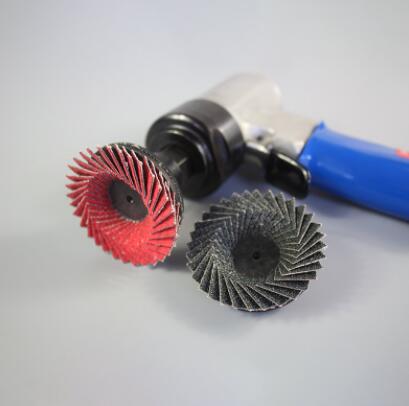Anti-corrosion quality control, in addition to attention to anti-corrosion materials, but also through the effective construction to give full play to. The anti-corrosion industry is known as "three parts material seven parts construction" is the truth, and the construction of the surface treatment is the most important. According to incomplete statistics, the surface treatment in the coating quality of factors affecting the proportion of 49.5%. In addition to mechanical sandblasting, most of the surface treatment is done by traditional manual grinding, such as steel structure rust removal, tank refurbishment, etc. The tools used are pneumatic or electric sanding machines (or called grinders).

There are two types of grinding machines for surface treatment, 100 and 125, and there are many kinds of grinding discs, such as steel wire wheel grinding disc, hundred blade grinding disc, grinding wheel grinding disc, etc. The most popular one is steel wire wheel grinding disc, and Yongkang, Zhejiang Province, China is an important production base for steel wire wheel grinding disc. In the actual steel structure anti-corrosion surface treatment construction, found that the steel wire wheel grinding disc grinding many defects, in addition to the absence of any roughness, is the metal grinding each other metal powder sludge pollution, resulting in a serious decline in the quality of the coating, especially adhesion, and even off. Although many standards specify the level of manual grinding quality requirements; however, there is no standard for grinding disc material for rigid provisions, such as GB/T8923.1-2011 "surface treatment of steel before coating surface cleanliness of the visual assessment of Part 1: uncoated steel surface and comprehensive removal of the original coating of steel surface rust level and treatment level" (equivalent to the use of international standards) ISO8501-1:2007), GB/T18839.3-2002 "Surface treatment of steel before coating Surface treatment methods Manual and power tool cleaning" (equivalent to international standard ISO8504-3:1988), SSPC-SP2 "Hand tool cleaning".

GB/T8923.1-2011 describes St2 and St3 rust removal grades as follows: "St2 thorough hand and power tool cleaning, when observed without magnification, the surface should be free of visible oil, grease and dirt and free of poorly adhered oxidation, rust, coatings and foreign impurities" "St3 very thorough hand and power tool cleaning, same as St2, but the surface finish should be much more thorough and the surface should have the luster of a metallic substrate". Actual no foreign impurities, there is a metal substrate luster is difficult to achieve, the author from the long-term anti-corrosion surface treatment grinding process practice, found that the wire wheel grinding disc in the process of rust removal, is a similar to the role of polishing, in addition to grinding away the surface rust layer also polished with the underlying metal each other to form a mirror effect, without any roughness, nor is it possible to have a substrate luster (exactly the substrate luster is the original color of the metal); and Most of the metal powder brought by wear and polishing forms black "sludge", and this "sludge" impurity cannot be completely cleaned up even by using solvents or other methods, and it increases the cost, which is a great help to the simple manual surface treatment. This is undoubtedly a snake's foot, and then the short steel wire splashed by the wire wheel polishing is like a flying arrow, which brings a great hidden danger to the safety. Therefore, the wire wheel grinding and rust removal process is an important cause of coating defects or even fall off consequences, is a direct factor of adhesion reduction. In addition, the wire wheel material and metal material is a different kind of metal, in the grinding process, the embedded metal particles may produce a potential difference, which will form a cathodic protection effect, which is a fatal damage to the adhesion of the primer material. Therefore, many experts and technical personnel in the industry, including the author of the corrosion prevention workers agreed that the use of steel wire wheel grinding disc grinding rust removal is extremely inappropriate, should be strictly prohibited to use. Corrosion prevention heavyweight expert Professor Li Rongjun in his book "heavy anti-corrosion coatings and painting" (Chemical Industry Press 2014 edition) "surface treatment before painting" chapter also pointed out that "with power tools or manual cleaning, try not to use wire wheel brush, because it may make the pollutants spread and surface polishing, affecting the adhesion and quality of the coating." I suggest that the surface treatment of grinding and rust removal discs to avoid the use of wire wheels, as far as possible to use such as a hundred blades grinding discs, grinding wheel discs and other non-metallic abrasives made of grinding discs, these grinding discs compared to wire wheel grinding discs, although the loss is relatively large, increasing the cost; but from the cleanliness, roughness and coating adhesion, is still the best rust removal discs, basically can meet the GB/T8923.1- 2011 "Surface treatment of steel before coating, visual assessment of surface cleanliness part 1: uncoated steel surface and steel surface rust grade and treatment grade after full removal of the original coating" (equivalent to the international standard ISO8501-1:2007) St2, St3 requirements, but the color requirements are open to question.
It was not until the late 1930s that the mechanical sandblasting process emerged. After World War II, the U.S. Navy introduced sandblasting into the painting project, and the traditional sanding and rust removal process was gradually replaced by sandblasting; however, because the sanding process is convenient and flexible, low-cost, not limited by location and area, fast, less pollution and other advantages that the sandblasting process does not have However, because the sanding process is convenient and flexible, low-cost, not limited by location and area, fast and less pollution, etc., it is still in use. We firmly believe that with the development of anti-corrosion surface treatment technology, especially the improvement of the degree of intelligence, the traditional grinding and rust removal process will eventually be launched into the historical stage.
We believe that today's manual or power grinding and rust removal process is a transitional period of surface treatment, as some heavy anti-corrosion fields and special coatings can not use the grinding process; even if the ordinary anti-corrosion surface treatment using the grinding process, we also hope that as far as possible not to use steel wire wheel grinding disc, but must use a hundred blades grinding disc, grinding wheel grinding disc and other non-metallic abrasive discs to ensure the coating performance The full play of the coating performance and anti-corrosion quality and safety.